Related Research Articles

The Secret Museum or Secret Cabinet in Naples is the collection of 1st-century Roman erotic art found in Pompeii and Herculaneum, now held in separate galleries at the National Archaeological Museum in Naples, the former Museo Borbonico. The term "cabinet" is used in reference to the "cabinet of curiosities" - i.e. any well-presented collection of objects to admire and study.
Lucius Aelius Lamia was a Roman Senator who held a number of offices under Augustus and Tiberius. He was consul in the year AD 3 with Marcus Servilius as his colleague.
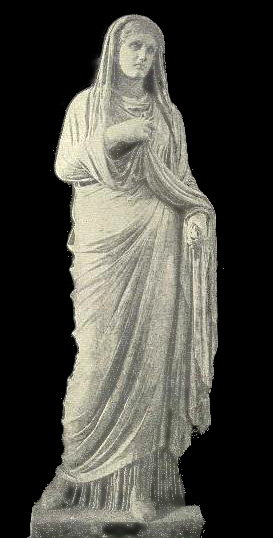
Eumachia was a Roman business entrepreneur and priestess. She served as the public priestess of Venus Pompeiana in Pompeii as well as the matron of the Fullers guild. She is known primarily from inscriptions on a large public building which she financed and dedicated to Pietas and Concordia Augusta.
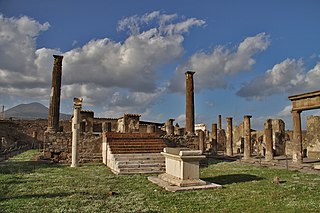
The Temple of Apollo, also known as the Sanctuary of Apollo, is a Roman temple built in 120 BC and dedicated to the Greek and Roman god Apollo in the ancient Roman town of Pompeii, southern Italy. The sanctuary was a public space influenced by Roman colonists to be dedicated to Greco-Roman religion and culture.
Ulpia was a noble Roman woman from the gens Ulpia settled in Spain during the 1st century CE. She was the paternal aunt of the Roman emperor Trajan and the paternal grandmother of the emperor Hadrian.
Don Paul Fowler was an English classicist.
Susan Treggiari is an English scholar of ancient Rome, emeritus professor of Stanford University and retired member of the Faculty of Classics at the University of Oxford. Her specialist areas of study are the family and marriage in ancient Rome, Cicero and the late Roman Republic.
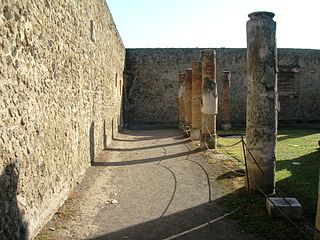
Caius Norbanus Sorex was an actor who lived in Italy and was active at Pompeii and Nemi during the time of Augustus.
Gaius Ummidius Actius Anicetus was a Roman pantomime actor who lived in Pompeii.
The gens Helvia was a plebeian family at ancient Rome. This gens is first mentioned at the time of the Second Punic War, but the only member of the family to hold any curule magistracy under the Republic was Gaius Helvius, praetor in BC 198. Soon afterward, the family slipped into obscurity, from which it was redeemed by the emperor Pertinax, nearly four centuries later.
Professor Lynette Gail Mitchell is Professor in Greek History and Politics at the University of Exeter. Mitchell is known for her work on ancient Greek politics and kingship.
Susanna H. Morton Braund is a professor of Latin poetry and its reception at the University of British Columbia.

Zahra Newby is Professor of Classics and Ancient History at the University of Warwick. She is known in particular for her work on Greek mythology in Roman art and the visual culture of Greek festivals in the Roman east. Newby is currently the Senior Tutor in the Classics and Ancient History Department at the University of Warwick.
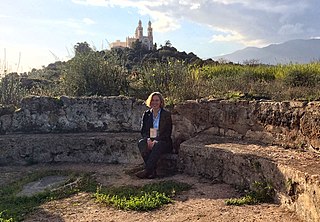
Catherine Mary Conybeare is an academic and philologist and an authority on Augustine of Hippo. She is currently Leslie Clark Professor in the Humanities at Bryn Mawr College in Pennsylvania.

Jennifer Baird, is a British archaeologist and academic. She is Professor in Archaeology at Birkbeck, University of London. Her research focuses on the archaeology of Rome's eastern provinces, particularly the site of Dura-Europos.
Anna Chahoud is Professor of Latin in the Department of Classics at Trinity College Dublin, and is known for her research on Latin literature and linguistics.
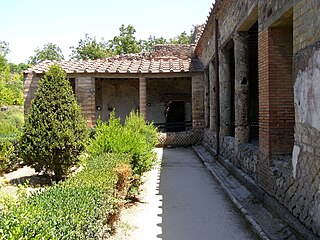
The gens Istacidia was an obscure Roman family at Pompeii. No members of this gens are mentioned by ancient writers, but a number are known from inscriptions. Numerius Istacidius Cilix was one of the municipal duumvirs of Pompeii around the beginning of the first century. The Istacidii were apparently the residents of the famous "Villa of the Mysteries", and a large sepulchre found along the bay road contains several tombs for members of this family.
Umbricia Fortunata was a businesswoman known from the Roman city of Pompeii. She produced the popular seasoning garum, a fermented fish sauce.

Aulus Umbricis Scaurus was a Pompeiian manufacturer-merchant, known for the production of garum and liquamen, a staple of Roman cuisine. He was active in Pompeii between c. 25-35 CE and 79 CE. Scholars believe that A. Umbricius Scaurus was Pompeii's leading fish sauce manufacturer. His products were traded across the Mediterranean in the first century.

Freedmen in ancient Rome existed as a distinct social class (liberti or libertini), with former slaves granted freedom and rights through the legal process of manumission. The Roman practice of slavery utilized slaves for both production and domestic labour, overseen by their wealthy masters. Urban and domestic slaves especially could achieve high levels of education, acting as agents and representatives of their masters' affairs and finances. Within Roman law there was a set of practices for freeing trusted slaves, granting them a limited form of Roman citizenship or Latin rights. These freed slaves were known in Latin as liberti (freedmen), and formed a class set apart from freeborn Romans. While freedmen were barred from some forms of social mobility in Roman society, many achieved high levels of wealth and status. Liberti were an important part of the "most economically active and innovative entrepreneurial class" in the Roman Empire. The legal and social status of freedmen remained a point of cultural and legal contention throughout the Republic and Empire.
References
- 1 2 Prof Alison Cooley. Department of Classics and Ancient History, University of Warwick, 13 January 2025. Retrieved 13 January 2025. Archived here.
- ↑ Bohdan Chernyukh, review of Alison E. Cooley, The Cambridge Manual of Latin Epigraphy, in Censurae Librorum, pp. 128-129.
- ↑ Alison E. Cooley, M.G.L. Cooley, Pompeii and Herculaneum: A Sourcebook. Review by Jacqueline Frost DiBiasie, Bryn Mawr Classical Review 2014.08.03.